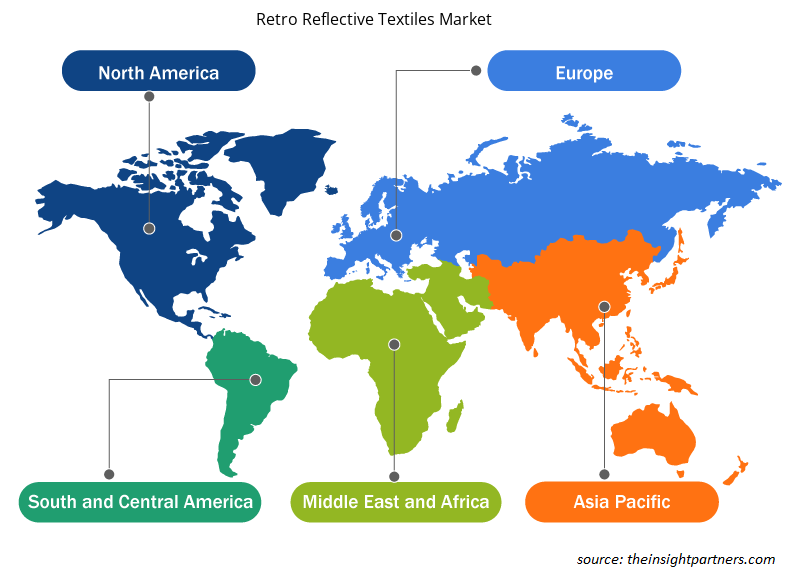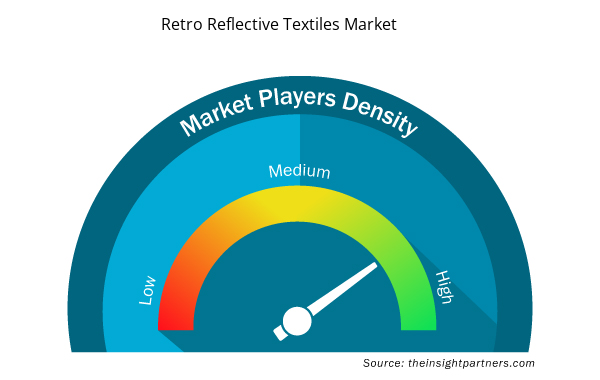[研究报告] 逆反射纺织品市场预计将从 2021 年的 28.728 亿美元增长到 2028 年的 41.398 亿美元;预计2021 年至 2028 年的复合年增长率为 5.4%。
反光布由能将光反射回光源的小玻璃珠制成。它被广泛用于建筑和运输等行业的防护服中。由于各国政府制定的安全法规,对反光纺织品的需求有所增加。此外,采矿业等终端用户行业事故数量的增加推动了对反光纺织品的需求。2020
年,亚太地区占据全球市场的最大份额;预计在预测期内将实现最高的复合年增长率。印度、中国和日本是主要的市场股东。汽车、交通运输、建筑和基础设施等行业的高增长对亚太地区 反光纺织品市场产生了重大影响。亚太地区的建筑和基础设施行业正在增长。
定制此报告以满足您的需求
您可以免费定制任何报告,包括本报告的部分内容、国家级分析、Excel 数据包,以及为初创企业和大学提供优惠和折扣
- 获取此报告的关键市场趋势。这个免费样品将包括数据分析,从市场趋势到估计和预测。
COVID-19 疫情对反光纺织品市场的影响
2021 年,各经济体开始复苏,对全球市场产生了积极影响。预计不同应用领域对反光纺织品的需求也将大幅增加,例如制造安全服装。此外,制造商可以满负荷运转以弥补供需缺口。此外,各国许多公民都已完全接种疫苗,各国政府正在对建筑、基础设施和制造业进行投资。预计各种终端使用行业的增长将导致预测期内对反光纺织品的需求旺盛。
市场洞察
劳动力安全措施和高能见度安全服装 ( HVSA )的重要性日益增加
在工作场所,如建筑工地的道路、石油和天然气工业、化学工业和采矿场,事故和死亡事件越来越常见,因为能见度低是一个问题。工业区经常使用起重机等重型机械。缺乏防护设备的工人更容易发生事故、受伤和死亡,因为这些重型机械的操作员不容易发现他们。此外,数百万工人在交通和建筑设备附近工作时容易发生撞击、碾压和倒车事故。工作场所安全的重要性日益增加,预计将在预测期内推动反光纺织品市场的增长。
最终用户洞察
根据最终用户,全球市场细分为建筑、石油和天然气、采矿、运输、消防员、执法机构等。2020 年,建筑部门占据了最大的收入份额;预计在预测期内将以最高的复合年增长率增长。随着城市化的快速发展,建筑工地也在不断扩大,这导致了许多以城市热岛为代表的热环境问题。这些反射器用于建筑工地的招牌、人员服装和车辆。逆反射纺织品被认为是一种创新解决方案,可以减少制冷所需的能量并改善城市小气候。逆反射纺织材料可提高可见度,是必不可少的配件材料。此外,建筑和基础设施活动的快速增加导致招牌和道路彩色标记的使用增加,从而推动了市场的增长。逆反射纺织品市场的主要驱动力是对建筑和基础设施领域的大规模投资。
3M;道明光学化工有限公司;杭州华星反光材料有限公司;黄山 星威 反光材料有限公司;PS ENTERPRISES;Swicofil AG;Unitika Sparklite Ltd. ; YGM Reflective;HJ Corp;和HIGHVIZ是反光纺织品市场的参与者。这些公司为市场提供了广泛的产品组合。这些公司在发展中地区的存在为反光纺织品市场提供了丰厚的机会。市场参与者正在开发高质量和创新的产品以满足客户的要求。
反光纺织品市场区域洞察
Insight Partners 的分析师已详尽解释了预测期内影响反光纺织品市场的区域趋势和因素。本节还讨论了北美、欧洲、亚太地区、中东和非洲以及南美和中美洲的反光纺织品市场细分和地理位置。

- 获取反光纺织品市场的区域特定数据
反光纺织品市场报告范围
| 报告属性 | 细节 |
|---|---|
| 2021 年市场规模 | 28.7 亿美元 |
| 2028 年市场规模 | 41.4亿美元 |
| 全球复合年增长率(2021 - 2028) | 5.4% |
| 史料 | 2019-2020 |
| 预测期 | 2022-2028 |
| 涵盖的领域 | 按最终用户
|
| 覆盖地区和国家 | 北美
|
| 市场领导者和主要公司简介 |
|
反光纺织品市场参与者密度:了解其对业务动态的影响
反光纺织品市场正在快速增长,这得益于终端用户需求的不断增长,而这些需求又源于消费者偏好的不断变化、技术进步以及对产品优势的认识不断提高等因素。随着需求的增加,企业正在扩大其产品范围,进行创新以满足消费者的需求,并利用新兴趋势,从而进一步推动市场增长。
市场参与者密度是指在特定市场或行业内运营的企业或公司的分布情况。它表明在给定市场空间中,相对于其规模或总市场价值,有多少竞争对手(市场参与者)存在。
在反光纺织品市场运营的主要公司有:
- 3M
- 道明光学化工有限公司
- 杭州华星反光材料有限公司
- 黄山市兴伟反光材料有限公司
- 普罗莫斯蒂
免责声明:上面列出的公司没有按照任何特定顺序排列。

- 了解反光纺织品市场的主要参与者概况
报告亮点
- 市场上不断发展的行业趋势,帮助参与者制定有效的长期战略
- 发达市场和发展中市场采用的业务增长战略
- 2019 年至 2028 年反光纺织品市场定量分析
- 全球反光纺织品需求量预测
- 波特的五力分析说明了行业中买家和供应商的效力
- 了解竞争市场状况的最新发展
- 市场趋势和前景以及推动和制约反光纺织品市场增长的因素
- 通过强调支撑商业利益的市场策略来协助决策过程,从而促进市场增长
- 不同节点的市场规模
- 市场详细概述和细分,以及反光纺织品行业动态
- 各地区反光纺织品市场规模及增长潜力巨大
“2028 年全球反光纺织品市场分析”是一项针对化学品和材料行业的专业深入研究,特别关注全球反光纺织品市场。该报告旨在通过详细的市场细分提供市场概述。反光纺织品市场根据最终用户、材料和地理位置进行细分。根据最终用户,反光纺织品市场细分为建筑、石油和天然气、采矿、运输、消防员、执法机构等。根据材料,市场细分为特多龙棉、涤纶、芳纶等。按地理位置划分,反光纺织品市场大致分为北美、欧洲、亚太地区 (APAC)、中东和非洲 (MEA) 以及南美洲和中美洲。
公司简介
- 3M
- 道明光学化工有限公司
- 杭州华星反光材料有限公司
- 黄山市兴伟反光材料有限公司
- PS 企业
- 瑞士斯威科菲尔公司
- 尤尼吉可 Sparklite 有限公司
- YGM 反光
- HJ 公司
- 高维兹
- 历史分析(2 年)、基准年、预测(7 年)及复合年增长率
- PEST 和 SWOT 分析
- 市场规模价值/数量 - 全球、区域、国家
- 行业和竞争格局
- Excel 数据集



Report Coverage
Revenue forecast, Company Analysis, Industry landscape, Growth factors, and Trends

Segment Covered
This text is related
to segments covered.

Regional Scope
North America, Europe, Asia Pacific, Middle East & Africa, South & Central America

Country Scope
This text is related
to country scope.
常见问题
Development of fashion clothing with retro reflective fabric is the key trend for the global retro reflective textiles market. The retro reflective materials are gaining massive traction in the fashion industry. The reflective fabric has become a new fashion trend in recent years, with it being extensively utilized in casual clothing, fashion wear, backpacks, pet jackets, and much more.
Based on end-user, the construction segment led the global retro reflective textiles market in 2020. At construction sites, the worker are required to wear high visibility safety apparel to avoid accidents and help the oncoming traffic to spot them.
Based on the material segment, tetoron cotton is expected to be the fastest-growing segment. The material segment includes tetoron cotton, polyester, aramid and others.
Growing importance of workforce safety measures and high visibility safety apparel (HVSA) along with rising demand from various end-use industries drives the retro reflective textile industry. The primary growth driver identified in the retro reflective textiles market is the large-scale investment in the construction and infrastructure sector. It is anticipated that infrastructural connectivity projects such as the expansion of road and railway networks would generate extensive demand for safety materials used in these projects. The retro reflective textiles market is expected to witness a significant boost in the coming years.
In 2020, Asia Pacific accounted for the largest share of the global retro reflective textiles market. The retro reflective textile industry is anticipated to expand faster due to increasing awareness of work safety clothes and high visibility safety apparel.
The major players operating in the global retro reflective textiles market are 3M; Daoming Optics and Chemical Co., Ltd; HANGZHOU CHINASTARS REFLECTIVE MATERIAL CO., LTD; Huangshan Xingwei Reflectorized Material Co., Ltd; PROMOSTY; PS Enterprises; Shelby Ltd; Swicofil AG; UNITIKA SPARKLITE LTD.; V-Reflex Reflective Material Co., Ltd.
Trends and growth analysis reports related to Chemicals and Materials : READ MORE..
The List of Companies - Retro Reflective Textiles Market
- 3M
- Daoming Optics and Chemical Co., Ltd
- HANGZHOU CHINASTARS REFLECTIVE MATERIAL CO.,LTD
- Huangshan Xingwei Reflectorized Material Co., Ltd
- PROMOSTY
- PS Enterprises
- Shelby Ltd
- Swicofil AG
- UNITIKA SPARKLITE LTD.
- V-Reflex Reflective Material Co., Ltd.
The Insight Partners performs research in 4 major stages: Data Collection & Secondary Research, Primary Research, Data Analysis and Data Triangulation & Final Review.
- Data Collection and Secondary Research:
As a market research and consulting firm operating from a decade, we have published and advised several client across the globe. First step for any study will start with an assessment of currently available data and insights from existing reports. Further, historical and current market information is collected from Investor Presentations, Annual Reports, SEC Filings, etc., and other information related to company’s performance and market positioning are gathered from Paid Databases (Factiva, Hoovers, and Reuters) and various other publications available in public domain.
Several associations trade associates, technical forums, institutes, societies and organization are accessed to gain technical as well as market related insights through their publications such as research papers, blogs and press releases related to the studies are referred to get cues about the market. Further, white papers, journals, magazines, and other news articles published in last 3 years are scrutinized and analyzed to understand the current market trends.
- Primary Research:
The primarily interview analysis comprise of data obtained from industry participants interview and answers to survey questions gathered by in-house primary team.
For primary research, interviews are conducted with industry experts/CEOs/Marketing Managers/VPs/Subject Matter Experts from both demand and supply side to get a 360-degree view of the market. The primary team conducts several interviews based on the complexity of the markets to understand the various market trends and dynamics which makes research more credible and precise.
A typical research interview fulfils the following functions:
- Provides first-hand information on the market size, market trends, growth trends, competitive landscape, and outlook
- Validates and strengthens in-house secondary research findings
- Develops the analysis team’s expertise and market understanding
Primary research involves email interactions and telephone interviews for each market, category, segment, and sub-segment across geographies. The participants who typically take part in such a process include, but are not limited to:
- Industry participants: VPs, business development managers, market intelligence managers and national sales managers
- Outside experts: Valuation experts, research analysts and key opinion leaders specializing in the electronics and semiconductor industry.
Below is the breakup of our primary respondents by company, designation, and region:

Once we receive the confirmation from primary research sources or primary respondents, we finalize the base year market estimation and forecast the data as per the macroeconomic and microeconomic factors assessed during data collection.
- Data Analysis:
Once data is validated through both secondary as well as primary respondents, we finalize the market estimations by hypothesis formulation and factor analysis at regional and country level.
- Macro-Economic Factor Analysis:
We analyse macroeconomic indicators such the gross domestic product (GDP), increase in the demand for goods and services across industries, technological advancement, regional economic growth, governmental policies, the influence of COVID-19, PEST analysis, and other aspects. This analysis aids in setting benchmarks for various nations/regions and approximating market splits. Additionally, the general trend of the aforementioned components aid in determining the market's development possibilities.
- Country Level Data:
Various factors that are especially aligned to the country are taken into account to determine the market size for a certain area and country, including the presence of vendors, such as headquarters and offices, the country's GDP, demand patterns, and industry growth. To comprehend the market dynamics for the nation, a number of growth variables, inhibitors, application areas, and current market trends are researched. The aforementioned elements aid in determining the country's overall market's growth potential.
- Company Profile:
The “Table of Contents” is formulated by listing and analyzing more than 25 - 30 companies operating in the market ecosystem across geographies. However, we profile only 10 companies as a standard practice in our syndicate reports. These 10 companies comprise leading, emerging, and regional players. Nonetheless, our analysis is not restricted to the 10 listed companies, we also analyze other companies present in the market to develop a holistic view and understand the prevailing trends. The “Company Profiles” section in the report covers key facts, business description, products & services, financial information, SWOT analysis, and key developments. The financial information presented is extracted from the annual reports and official documents of the publicly listed companies. Upon collecting the information for the sections of respective companies, we verify them via various primary sources and then compile the data in respective company profiles. The company level information helps us in deriving the base number as well as in forecasting the market size.
- Developing Base Number:
Aggregation of sales statistics (2020-2022) and macro-economic factor, and other secondary and primary research insights are utilized to arrive at base number and related market shares for 2022. The data gaps are identified in this step and relevant market data is analyzed, collected from paid primary interviews or databases. On finalizing the base year market size, forecasts are developed on the basis of macro-economic, industry and market growth factors and company level analysis.
- Data Triangulation and Final Review:
The market findings and base year market size calculations are validated from supply as well as demand side. Demand side validations are based on macro-economic factor analysis and benchmarks for respective regions and countries. In case of supply side validations, revenues of major companies are estimated (in case not available) based on industry benchmark, approximate number of employees, product portfolio, and primary interviews revenues are gathered. Further revenue from target product/service segment is assessed to avoid overshooting of market statistics. In case of heavy deviations between supply and demand side values, all thes steps are repeated to achieve synchronization.
We follow an iterative model, wherein we share our research findings with Subject Matter Experts (SME’s) and Key Opinion Leaders (KOLs) until consensus view of the market is not formulated – this model negates any drastic deviation in the opinions of experts. Only validated and universally acceptable research findings are quoted in our reports.
We have important check points that we use to validate our research findings – which we call – data triangulation, where we validate the information, we generate from secondary sources with primary interviews and then we re-validate with our internal data bases and Subject matter experts. This comprehensive model enables us to deliver high quality, reliable data in shortest possible time.


 获取此报告的免费样本
获取此报告的免费样本